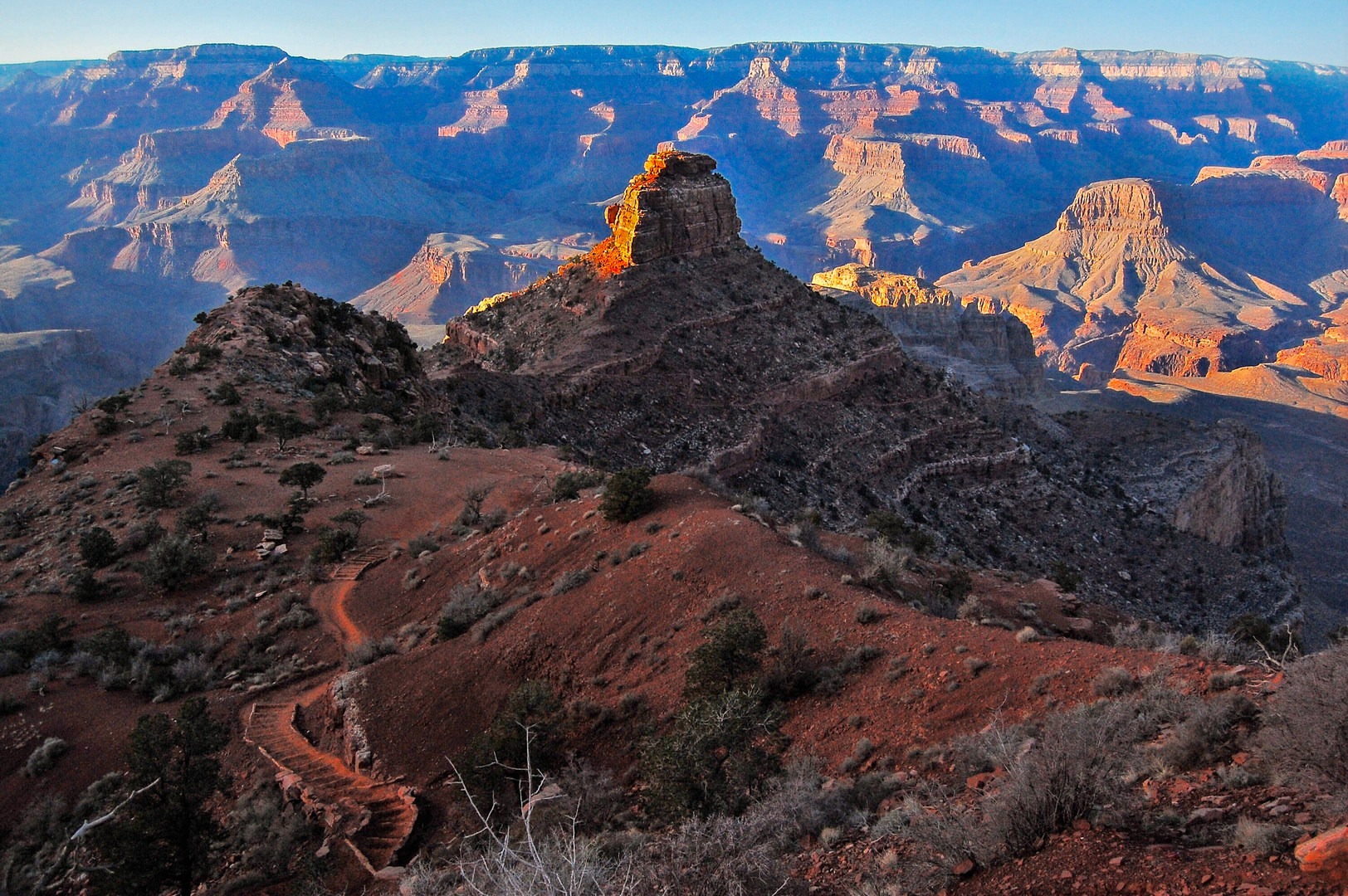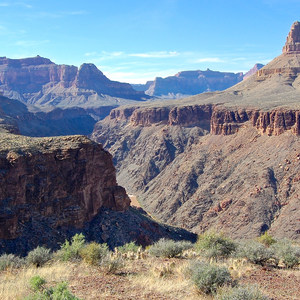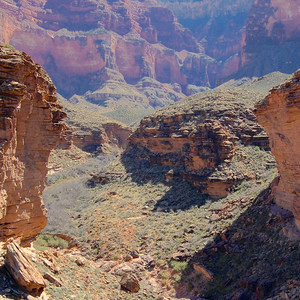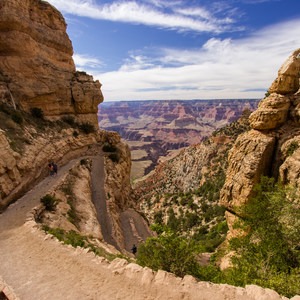You are here
There may be no other hiking destination in the country that is more famous and more revered than the Grand Canyon. It’s earned this reputation by its dramatic beauty, of course, but also by the sheer difficulty of its steep, rugged, desert trails.
Nearly 6 million people visit this natural wonder each year. While most stick to the relative comfort of overlooks and lodges on the rim, many venture down into the canyon to gaze up at the massive rock walls or feel the crisp Colorado River. Hiking the Grand Canyon isn't a simple endeavor, but anyone in decent physical condition can experience at least a few miles of its spectacular trails.
Below you'll find tips on day hiking, overnight stays, more advanced adventures, and a few trail profiles. No matter your level of experience, you should find this guide helpful for your grand journey.
Day Hiking
Day hikes are by far the most popular type of trip into the Grand Canyon. A down-and-back excursion lets you commit to traveling only as far as you think you can handle, and it allows for carrying less of a load to weigh you down. Nonetheless, hiking here presents many unique challenges, many that you may not think about on hikes elsewhere.
Climbing out will take more time.
This seems obvious, but many hikers get lured into descending further than they can reasonably return in a day. The trip downhill can be deceptively easy, but don’t let yourself get carried away; monitor your progress, your food and water, your energy, and how much daylight remains. You might be surprised at how quickly it gets dark once the sun drops below the canyon rim. Know when sunset is (remember that Arizona does not observe Daylight Savings Time), and remember to pack a headlamp and extra layers if you think you might be out later. Roads remain open in the park all night, so getting "nighted" isn’t necessarily a big deal as long as you are prepared.
If you are determined to get as far as you can in a day, plan your route and set a turnaround time before you even set foot on the trail to make sure that you have enough time and energy to get out before dark. Know your average hiking speed, and expect to go slower than normal when climbing out of the canyon. Maps are available for free at the park entrance, and rangers can provide detailed information on weather and trail conditions for the day.
While a round-trip day hike to bottom of the canyon is a lofty accomplishment, the National Park Service does not recommend it, especially during the warmer months. While the complete Rim-to-River and back is frequently completed by people who are physically fit and well prepared, you should only try it if you are experienced in desert hiking and confident in your abilities.
Weather can be extreme.
Seasonal extremes are part of this rugged landscape. Most people visit the Grand Canyon in the summer when temperatures regularly reach 110 degrees near the bottom of the canyon, yet temperatures at the breezy, high-elevation rim are often comfortably cool. In the Grand Canyon, temperatures rise as you descend. If you are not accustomed to physical activity in hot, dry conditions, hiking into the canyon can be more taxing than you might expect. In the winter, even though bright sun usually thaws the rim fairly quickly, ice can linger on shady switchbacks well into the spring. Winter hiking often warrants the use of trekking poles and spiked boots in the upper reaches of the canyon.
Weather can be unpredictable, as well. During the summer monsoon season, thunderstorms sweep up over the rim from out of sight, and winter snowstorms can approach just as suddenly. The North Rim, sitting at a higher elevation than the South Rim, is so susceptible to bad weather that it is closed during the winter.
Be prepared for conditions you might encounter, and while you should anticipate brutal heat in summer and bitter cold in winter, don’t be surprised if you get caught in exactly the opposite conditions.
Carry plenty of water and food.
In general, expect to eat and drink up to twice as much than you do in a normal day. Bring lots of dense, salty, high-calorie snacks; this may seem counterintuitive when you are trying to stay hydrated, but salt and other electrolytes are essential to keep your body working properly. One of the most common life-threatening conditions in the canyon is hyponatremia, wherein one drinks too much water without replacing electrolytes, and the body’s sodium levels drop dangerously low.
How much water to bring really depends on the weather and on what trail you are doing. Dehydration can be serious, so bringing too little is dangerious; but carrying too much water can be exhausting. Temperature forecasts are available at the visitor center and ranger stations each day, but remember that the inner canyon is always hotter than the rim. Also, some trails have plentiful water (like Bright Angel), while some have none (like South Kaibab). As a general rule, plan to drink up to one full liter of water per hour of hiking in hot weather. Pack enough bottles to carry up to three liters of water at a time, depending on the length of your hike. Also, water sources anywhere other than on the corridor trails may require purification, so pack accordingly.
Pack light and wear good shoes.
The less you carry the more quickly and comfortably you can travel, and this means packing only the essentials. Water and food should make up the most weight and space in your pack, but sunscreen, sunglasses, and a hat are also high priorities. Layers for warmth and light rain may be called for, and bring a headlamp if you might get caught in the dark. A small first aid kit (that you know how to use) should always be with you. Many people bring heavy camera equipment into the canyon, and this is truly one of the most photogenic places on Earth. Consider what you need and don’t need to get the shot. That tripod and those extra lenses will feel a whole lot bulkier on the hike back up.
Hikers on short trips can probably get away with wearing any decent tennis shoes or outdoor sandals, but hikers on lengthier hikes or more rugged trails will want lightweight, durable hiking boots—ones that have already been broken in and won’t give you blisters. Soft and snug socks are important to minimize the friction that causes blisters. Also, be careful to keep your socks and shoes dry; although splashing in Bright Angel Creek along North Kaibab Trail is inviting, you may want to do this barefoot so your feet won’t be soaked for the rest of the hike.
Listen to your body.
Be honest with yourself about your own limits. According to National Park Service surveys, nearly all first-time Grand Canyon hikers report that their trek was more difficult than expected. A little suffering to experience the inner canyon is par for the course, but there is often a fine line between a worthwhile endeavor and a miserable trip.
Pace yourself throughout the hike. If you are breathing too hard to talk while you walk, you should slow down. Take breaks often—to drink water, eat food, take in the scenery, snap photos, talk to other hikers, or whatever. If you know you have a condition that might hinder you on the hike, respect your limits and make sure others in your group are aware that you may need extra time or attention. Small problems, like sensitive knees or weak asthma, can quickly become major problems with sustained exertion. Whether you have a pre-existing condition or not, slow your pace and take breaks more often to avoid making the problem worse.
Overnight Backpacking
Spending the night is by far the best way to experience the Grand Canyon. You can take more time to enjoy the scenery on your trek and also travel farther in order to see more of it. Traveling to the bottom of the canyon in one day, camping at the bottom, and coming up the next day is the best strategy for seeing the Colorado River. Most people do not make it the river and back in one day.
Camping requires a permit.
Aside from Phantom Ranch Lodge, all overnight stays in the canyon require a paid permit from the park’s Backcountry Office, and documentation must be carried with you on the hike and displayed at your campsite. Permits specify the number of people in a party, the site(s) to be used, and the dates of stay. The park has a special system for administering a limited number of permits, so they are not always easy to get. Certain campsites, such as those at Bright Angel Campground in the bottom of the canyon, are in high demand and fill up fast.
The best way to secure a permit is to make reservations by mail, fax, or in person up to four months in advance of your trip. You can only request permits in person at the Backcountry Office between one and three months prior to your start date. The office also reserves a certain number of permits for last-minute in-person requests that can be arranged less than a month prior to your trip. All permits are issued on a first-come, first-served basis, and they can never be requested by phone or email. For details on permits, visit the Grand Canyon Backcountry Office.
Anticipate temperature swings.
If you are camping in the bottom of the canyon in the summer, chances are temperatures will remain comfortable through the night. During the winter, spring or fall, however, expect it to get uncomfortably cold after the sun goes down. If you are camping on the rim, you will probably want a warm layer after dark even during the summer. The Grand Canyon’s dry air does not hold heat very well, so temperatures drop quickly at night. Be sure to check the weather forecast and pack accordingly.
Pack light.
Whittle down your packing list to only the essentials, and tailor it carefully to the particular route and campsites you are using. For example, backcountry sites at Bright Angel Campground have picnic tables, food boxes, and bathrooms with running water. Other backcountry sites in the park do not, and some of them don’t have any type of toilet. Plan for water availability as well. Not all trails have plentiful water, so you may have to carry more with you. Many water sources require treatment, but if you can get by without it, leave the filter at home to save weight. Research your campsites, trails, and weather forecasts on the national park’s website beforehand so you know what to bring and, more importantly, what to leave.
Don’t feed the animals and pack out your trash.
We share the Grand Canyon with all kinds of wildlife, but it’s best for those creatures to stay wild and stay out of your food. Be sure to bring enough animal-proof boxes or bags to store all your food or they may chew holes in your pack to get inside. Even if you wander a short distance from your campsite during the day, your food should be safely stowed. Sunlight does little to deter some of the bolder furry fiends.
There is no garbage service at backcountry sites, not even at Phantom Ranch. All trash that you generate must be carried out with you. Some backcountry sites have toilets, but not all. Be sure to review the details of the campsite on your permit so you know what to expect.
Advanced Adventures
If you have already conquered the Rim-to-River or Rim-to-Rim in a day and now want to go faster or farther, read the tips in this section. You will also find these tips useful if you want to take on any multi-sport activities, like technical canyoneering or rock climbing, that require more gear and cross-country travel.
Plan, plan, plan!
Success depends on proper planning for logistics and packing. As soon as you start using obscure access points, combining multiple trails, or traveling cross-country, navigation gets exponentially harder. Know your intended route in addition to alternative routes, and be sure to take a topo map and a compass. Good trail maps for the Grand Canyon are hard to find online, but they are available for purchase at the park visitor center. USGS topo quads are also useful and come in print or as smartphone apps.
Scouting your route is even better; having your route dialed ahead of time is crucial. You can identify any landmarks that will help with navigation and leave rock cairns at tricky spots. And just like any other Grand Canyon excursion, you will want to carry only the essentials. For a one-day speed or distance push, your packing list won’t be much different than for a typical day hike. The key is to avoid carrying extra water by planning for spots to refill. Overnight trips or technical endeavors will require more gear, but you can minimize your load by searching online for information or talking to people who have done it before. Scouting the route yourself can help with this too.
Get creative.
If you want to go big you have to think big, and there are several handy tricks that may not be obvious. Here are just a few ideas, but there may be plenty of ‘outside the box’ options for your trip.
If you make a scouting mission, consider stashing water and food in a strategic location so you won’t have to carry as much on the big day.
Setting a vehicle for shuttle may be necessary, even if this means many hours of driving. It can take up to eight hours to drive from the South Rim to more remote locations on the North Rim, but a shuttle may be the only way to accomplish your big push. You could also arrange for a very nice someone to either drop you off at the start or pick you up at the finish to cut down drive time for yourself.
Packrafting is allowed on the Colorado River. With a backcountry camping permit, you are allowed to packraft up to 5 miles on the river as part of your route. The catch is that you have to plan your route with the Backcountry Office in person or provide a very detailed letter by mail. They will only authorize floating if there is no overland alternative to get where you need to go. It isn't always the most convenient option, but if you have access to a packraft, keep this possibility in mind.
If you are lucky enough to know people on a river trip, you might arrange for them to drop off or pick up gear in the bottom of the canyon. If you are doing an especially long route or anything that requires a lot of gear for only part of the trip, coordinating with a river trip can be the ultimate strategic advantage.
Don’t screw it up.
You should only embark on a grand adventure in the Grand Canyon if you are confident you will succeed. You don’t have to travel far to be truly on your own, and cell phone and radio reception is limited to non-existent. If you are prepared to get yourself into a dangerous situation, you should be prepared to get yourself out of it as well.
Aside from your own personal wellbeing, keep in mind the privilege of access for everyone else. Grand Canyon National Park is a great gift to the world. Be sure to keep it preserved by minimizing your impact on the land and ecology. Incidents like deaths and rescues can compromise future access for everyone. If you become a statistic, you may encourage park managers to impose tighter restrictions that hinder others from doing the activities you enjoy.
As an experienced Grand Canyon traveler, you know your own abilities and limitations. There is nothing wrong with pushing these, but the Grand Canyon is never the best place to do it. Don’t be afraid to dream big, just make sure to stay smart and stay safe.
The Trails
There are far more routes into the canyon than many people realize. However, there is a relatively small collection of trails dubbed as "corridor" trails that are maintained for heavy traffic and access the park's only bridges across the Colorado River. Also included are brief descriptions of a few unmaintained trails in the park. Note that Bright Angel Campground is located next to the Colorado River in the bottom of the canyon, so mileage to this point is the approximate distance to the river.
Bright Angel (Corridor)
This is the most popular route to and from the Colorado River. Although not the shortest trail, it has the most rest stops and water availability. The trail follows a natural fault line through the upper rock layers, then a series of spring-fed creek gorges the rest of the way down. It crosses the Colorado River near Phantom Ranch and provides easy access to the lodge and campgrounds there.
The trail is 9.3 miles to Bright Angel Campground and 9.8 miles to Phantom Ranch. Indian Garden, located about halfway at mile 4.5, is a shady oasis on a flat plateau. This is the day hike destination for many visitors who relax by the creek under huge cottonwood trees before turning back uphill.
Drinking water is available at mile markers 1.5 (First Resthouse), 3 (Second Resthouse), 4.5 (Indian Garden), 6.1 (Plateau Point), 9.3 (Bright Angel Campground), and 9.8 (Phantom Ranch). Water is reliable throughout the summer, but the Park Service only guarantees year-round availability at Indian Garden, Bright Angel Campground, and Phantom Ranch.
South Kaibab (Corridor)
This is the shortest route to the Colorado River, but not necessarily the easiest. It is steeper and hotter than the Bright Angel Trail, and there is no water available anywhere on the trail until the bottom of the canyon. Nonetheless, this trail remains extremely popular because it gives the best views in the shortest span of trail. You need only descend about 1 mile on this trail to gain sweeping panoramas of the inner canyon.
In total, it is 6.4 miles to Bright Angel Campground and 6.9 miles to Phantom Ranch. Many people make a short day hike by descending to Cedar Ridge at mile 1.5, taking plenty of pictures, and then turning back.
North Kaibab (Corridor)
This is the main trail descending from the North Rim. This side of the canyon is more remote and less visited, so this trail is less popular than the other corridor trails. This trail is, however, the most comfortable in summer and provides a wealth of spectacular side hikes. The trail follows Bright Angel Creek, which flows year round with cool, clear water. During the heat of summer you can wet your clothes or splash in the creek at many points along the trail. Side trails will take you to amazing spots like the famous Ribbon Falls.
This is also the longest corridor route to the Colorado River, reaching Phantom Ranch in 14.0 miles and Bright Angel Campground in 14.5 miles. Drinking water is available at mile markers 1.7 (Supai Tunnel), 4.7 (Roaring Springs), 6.9 (Cottonwood), 14.0 (Phantom Ranch), and 14.5 (Bright Angel Campground). Only Phantom Ranch and Bright Angel Campground are year-round potable water sources; the rest are turned off when temperatures get below freezing.
Hermit Trail
This is an unmaintained but well-traveled trail in the western side of the park. It offers entirely different views than any of the corridor trails and is used to access popular backcountry campsites at Hermit Creek and Monument Creek. A good day hike is to go to Dripping Springs and back (7 miles round trip) via the Drippings Springs side trail.
Water is available seasonally at mile 2.5 (Santa Maria Spring) and year round at mile 8.2 (Hermit Creek). If you take the side trail to Dripping Springs, you can get water seasonally at mile 3.5 as well. All these water sources are considered non-potable and require purification before drinking.
Grandview Trail
This trail is further east than the corridor trails, and it accesses the spectacular Horseshoe Mesa halfway down the canyon. You can also continue all the way to the Colorado River. A short day hike is to Coconino Saddle and back (2.2 miles round trip), and the longer option is to Horseshoe Mesa and back (6 miles round trip). There is no water available anywhere between the rim and Horseshoe Mesa, but some seasonal sources can be found if you continue past Horseshoe Mesa.








Comments
Sign In and share them.